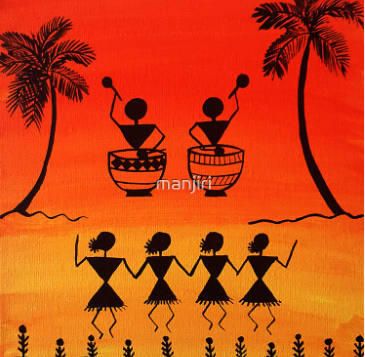In the heart of India, nestled within the tribal communities of Maharashtra, a traditional art form has flourished for centuries. Warli art, with its simplistic yet deeply expressive designs, is a testament to the rich cultural heritage of the Warli tribe. This age-old art form not only reflects the unique way of life of the tribal communities but also serves as a bridge between the past and the present. In this article, we will embark on a journey through the world of Warli art, exploring its history, significance, and the enduring traditions that keep it alive.
A Glimpse into History
Warli art can be traced back to over 2,000 years, making it one of the oldest art forms in India. Originating in the Warli region of Maharashtra, this art was traditionally used to adorn the walls of Warli huts. The distinctive use of simple geometric shapes, predominantly circles, triangles, and squares, embodies the tribal way of life, their deep connection to nature, and their belief in a higher power.
The Art of Storytelling
Warli art is not merely a form of decoration; it is a medium of storytelling. These intricate designs depict scenes from tribal life, conveying everyday activities like farming, fishing, and hunting, as well as spiritual rituals, festivals, and traditions. Warli art serves as a visual narrative of the tribe’s history and culture, passing down stories from one generation to the next.
The Aesthetic of Minimalism
One of the most striking aspects of Warli art is its minimalistic approach. The art form uses a stark palette of white, symbolizing purity and simplicity, on a mud or red ochre background. The stark contrast between the white motifs and the earthy backdrop creates a visually appealing and distinctive aesthetic. The minimalism of Warli art emphasizes the core values of the tribal community, focusing on the essential elements of life.
The Bond with Nature
Central to Warli art is the tribe’s profound connection with nature. Elements like trees, birds, animals, and humans are beautifully woven into the art. This bond with nature is a testament to the tribe’s sustainable way of living and their dependence on the land. The circle, which represents the sun and moon, stands as a symbol of the eternal cycle of life and nature.
Rituals and Celebrations
Warli art plays a significant role in tribal rituals and celebrations. During festivities and important events, the walls of huts are adorned with Warli paintings. These intricate designs, often accompanied by song and dance, serve as a form of worship and celebration. art is deeply ingrained in the tribe’s spiritual and cultural practices.
The Modern Resurgence
While art has deep historical roots, it has not remained static. In recent years, it has experienced a resurgence, with artists and artisans using it to create a wide range of products, from paintings and textiles to pottery and home décor. The modern interpretation of art has opened new avenues for the preservation of this ancient tradition while allowing it to evolve in contemporary contexts.
Preservation of Tradition
Preserving art is not only about continuing a tradition; it’s about empowering the tribal community. Organizations and initiatives have sprung up to support artists, providing them with platforms to showcase their work and access to a wider market. These efforts are crucial for sustaining the art form and ensuring the well-being of the Warli community.
Warli Art
Warli art is a timeless legacy, passed down through generations, serving as a living testament to the Warli tribe’s culture, history, and way of life. Its minimalistic beauty, deep connection with nature, and storytelling prowess make it a unique and cherished art form. As it finds its place in the modern world, continues to bridge the gap between the past and the present, connecting us to the rich tapestry of tribal traditions and culture. It is a journey worth taking, and one that showcases the enduring power of art to transcend time and space.







